14 Ingredient Swaps That Will Make Your Meatballs Taste So Much Better
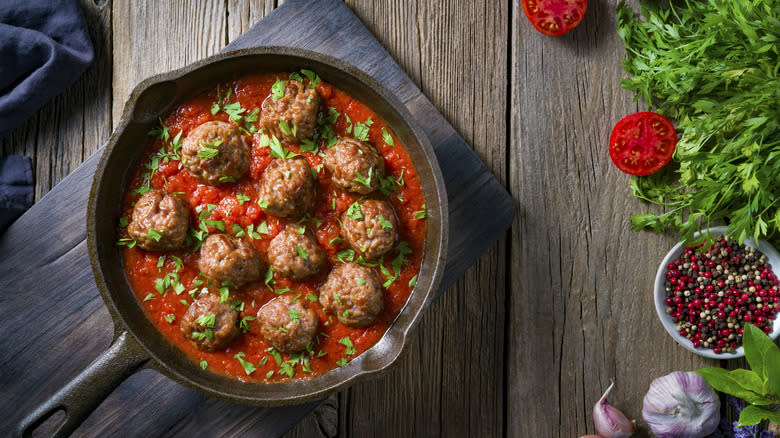
If there are people out there who don't love meatballs, we don't wanna know them. Whether you're making classic Italian meatballs or Swedish meatballs doused in cream sauce, the food brings flavor and sustenance to the table, and they're refreshingly easy to make at home. However, meatballs are often made in the same way every time, and by doing this, you miss out on a world of ingredient swaps that can amp up their flavor even further.
Meatballs, by their very nature, are versatile: Their composition, made of multiple different items, lends them a looseness and flexibility with their ingredients that invites experimentation. Changing up the meat you're using, by opting for a different type of red meat, a white meat, or even seafood, can give your meatballs a more developed, sometimes more subtle flavor. Opting for a different binder than the classic breadcrumbs can also infuse your meatballs with more taste. The seasonings you choose for your meatballs can unlock things even further, and you don't have to stick with the classic Italian herbs thrown into so many recipes. We'll show you all the ways you can jazz up your meatballs with a few easy swaps.
Read more: 15 Tips For Making The Best Meatloaf
Use Stuffing Mix Instead Of Breadcrumbs
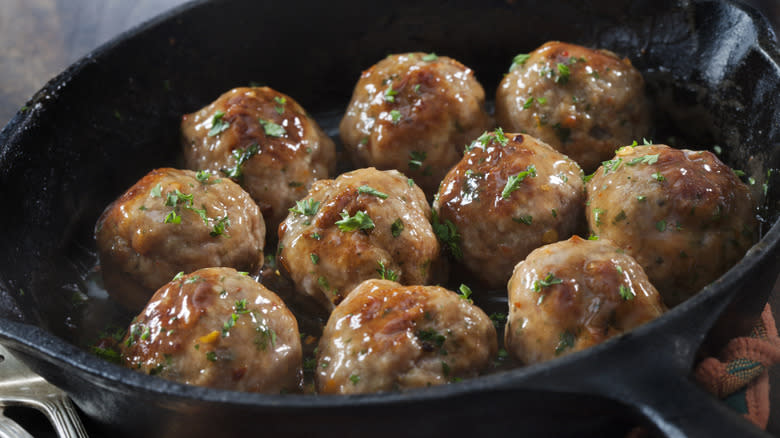
Breadcrumbs are highly effective as a meatball binder. When added to the meat mixture, they absorb some of its moisture and work as a glue for your other ingredients. Unfortunately, though, breadcrumbs are usually pretty flavorless, which means you're bulking out your meat with minimal flavor -- and that's why you should use stuffing mix instead of breadcrumbs for meatballs.
Stuffing mix gives you the best of both worlds: It's a meatball binder that's full of flavor. These mixes contain a blend of herbs, spices, and salt that infuses each bite with taste, while the breadcrumbs and flour in the mix help to keep the meat mixture together. Importantly, stuffing mix will only work with certain types of meatballs, and you'll need to make sure the flavors of the mix match your chosen recipe. It's also useful to remember that some stuffing mixes can be pretty salty, so make sure you're balancing things out by reducing your salt content elsewhere. Finally, remember that some stuffing mixes can make meatballs fairly dry, so don't be afraid to add a little extra water.
Instead Of Beef, Use Lamb
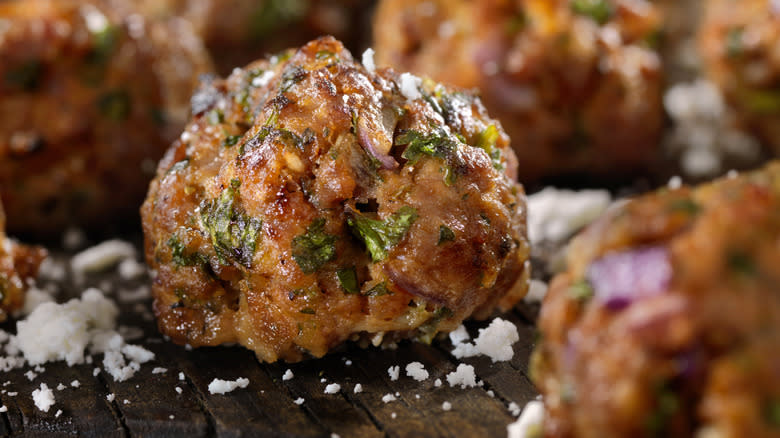
One of the easiest ways to make your meatballs more interesting is to swap your meat. In the United States, beef or a combination of beef and pork are the most common meat choices with meatballs. While these options are tried and tested, opting for lamb can give your meatballs a much richer flavor. Lamb has a gamier, slightly denser taste than beef and many ground lamb blends have a fairly high fat content, giving your meatballs a smoother texture.
Because of lamb's different flavor profile, the seasonings you use will need to change accordingly. Lamb goes excellently with warm, fragrant spices like cinnamon, cumin, and cayenne pepper, so it's a great choice if you're making meatballs with a little more heat. Additionally, it pairs seamlessly with woodier herbs. Lamb, rosemary & garlic meatballs are perfect for folks who want their dish to have a showstopping scent and a complex, slightly fruitier flavor profile. Lamb meatballs tend to work best when they're served with mashed potato, instead of pasta, but that doesn't mean you can't throw them into your spaghetti and twirl your noodles around them.
Rather Than Egg, Use Mashed Potatoes
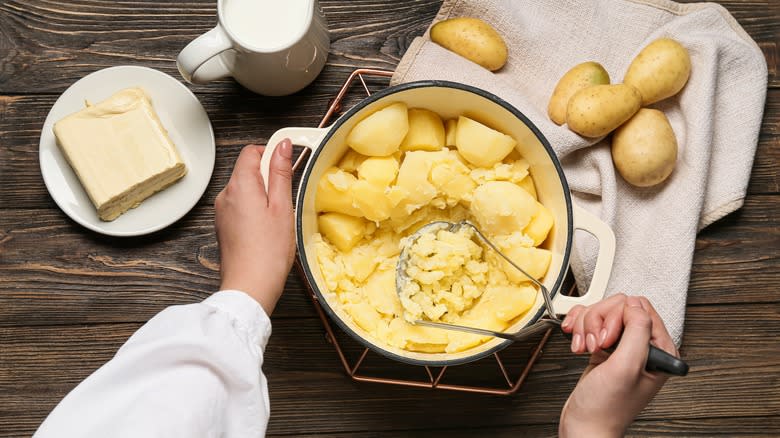
Countless meatball recipes use eggs, and folks, we get it. Eggs are one of the best binders out there and pull your ingredients together easily without adding too much extra flavor. They also provide some all-important fat content and give a slight creaminess to your meat. However, we urge you to forget the eggs, as mashed potatoes are the perfect way to bind meatballs. Mashed potatoes have the same binding power as eggs do, but they crucially have less moisture, meaning your meatballs are less likely to become spongy and overly soft.
Mashed potatoes also have a subtle, gently creamy flavor, meaning they don't intrude on your recipe's taste profile, but instead help to highlight the sharper flavors throughout. For every egg your recipe calls for, simply use a ¼ cup of mash. One thing you need to watch out for, though, is the moisture content of your mashed potatoes. If you've made something closer to a potato purée, all of this extra moisture will end up in your meatballs, and you run the risk of them being too loose and potentially falling apart. You want your potatoes to be fairly dry, but not so dry as to make your meatballs chalky.
For Chicken Meatballs, Swap White Meat For Dark
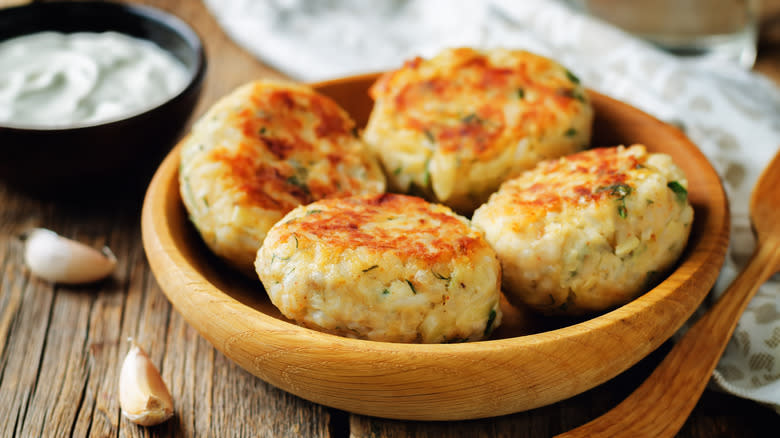
Chicken meatballs can have as much flavor as the beef or pork version, but they also suffer from a lot of dryness, which can leave them falling apart and you with a mouthful of mealy meat. That's why you should swap your regular ground chicken for dark meat. The reason why you need dark meat for the juiciest chicken meatballs is because of its higher fat content. This fat gives them more moisture, which both keeps the meat stuck to each other and stops them from drying out when cooked.
The fat also gives your meatballs a richer, deeper flavor, and as a bonus, you also get a boost of iron and zinc, which comes in higher quantities in dark meat than white meat. Remember, though, that you don't have to choose one or the other. You can make your own blend of dark and white meat, combining lightness and fatty flavor, by grinding your meat at home. Grab yourself a meat grinder (or use your food processor) and throw in chicken breasts and thighs, experimenting with different ratios until you get your ideal mix.
Instead Of Seasonings, Use French Onion Soup Mix
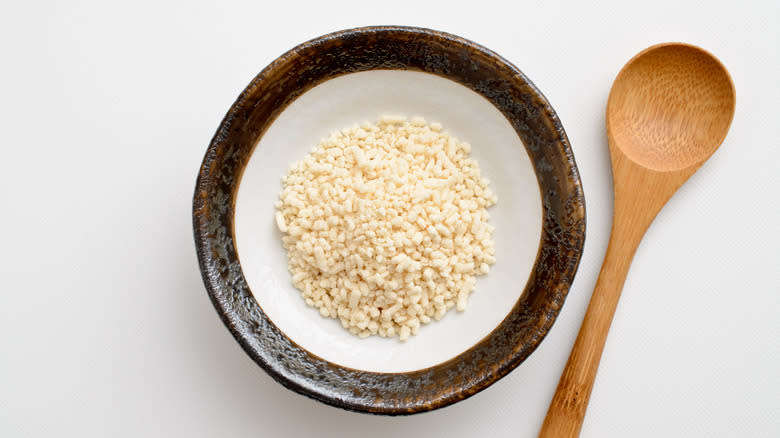
We all want our meatballs to be full of flavor, but combining a dozen different seasonings to achieve this can be a lot of work. It's also all too easy to miss a few crucial seasonings, leaving your final dish tasting flat. Save yourself the hassle and the risk of tastelessness, and use French onion soup mix instead, which is full of oniony, savory flavor. The mix packets are both simple to use and they'll add instant depth to your meatballs, without making them too wet.
French onion soup mixes often contain dehydrated soy sauce, which gives them a big dose of umami flavor and sweetness in the form of sugar or corn syrup. Crucially, these mix packets can be high in salt, so you'll likely want to reduce the amount of salt you add through other seasonings. It's also worth bearing in mind that the intense onion flavor that these mixes provide means that you may want to reduce the amount of raw onions you add, so you don't totally overwhelm your meatballs' flavor.
Don't Use Herbs — Use Cinnamon Instead
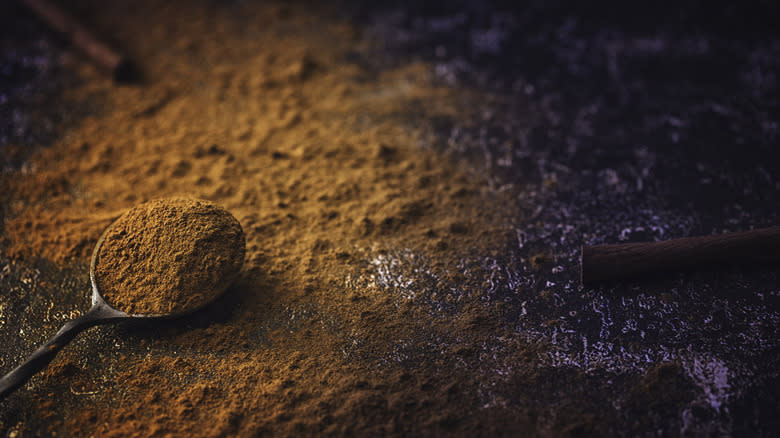
Italian meatballs, infused with dried herbs like oregano and parsley, will never be unpopular. However, we're a big fan of creating a flavor profile out of spices instead of herbs –- and cinnamon has to be one of our favorites. Cinnamon is just as good in savory foods as it is in sweet ones, and it infuses meat with a warm, aromatic, gently spicy taste. Its earthy flavor melds perfectly with red meat like beef, but it's especially good with lamb, and it can even work well with lighter meat like veal or chicken meatballs made with dark meat.
To use cinnamon in all its glory, pair it with a host of related flavors. Moroccan meatballs with spicy eggplant and tomato sauce is the perfect recipe to see this in action. In this dish, cinnamon is paired with cumin and the sultry flavors of paprika, and then contrasted by a pop of lemon zest and the floral, spicy notes of fresh cilantro. The meatballs are cooked alongside the mellow, squidgy eggplant, which balances out their savory profile with some necessary vegetal notes. The spicy tomato sauce brings everything together, in glorious harmony.
Sub Your Egg For Tomato Passata
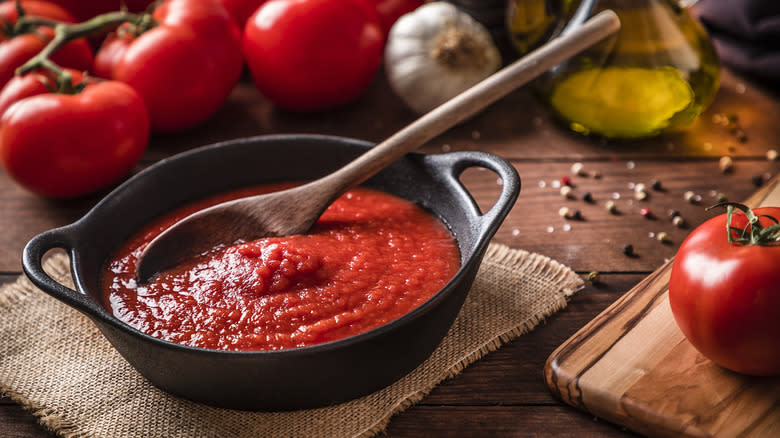
Here's the thing about eggs: They're good at taking on other flavors, but they don't really have a lot of flavor themselves. This makes them a subtle, inoffensive binder, but it doesn't make them great at boosting the taste of your meatballs. Tomato passata, on the other hand, is another story. Tomato passata is the Italian secret to upgrading any tomato sauce, and in meatballs it offers a threefold benefit, giving texture, flavor, and binding ability.
Tomato passata is, essentially, a more intense version of tomato paste. Made with late summer tomatoes, it has a rich flavor that adds umami and acidity to meatballs. Because it's smooth, it combines effortlessly and doesn't leave you with any chunks of tomato that ruin their texture. Passata's high moisture content brings your meat together and keeps the meatballs juicy when cooked.
Importantly, just adding passata to your meatballs will make them taste of tomato fairly heavily. You'll likely want to add a few extra things to round out their flavor. Worcestershire sauce, soy sauce, or onion and garlic powder are a great way to add extra layers. If you find that your passata makes things too wet, balance it out with some breadcrumbs.
Skip Your Regular Protein And Use Seafood Instead
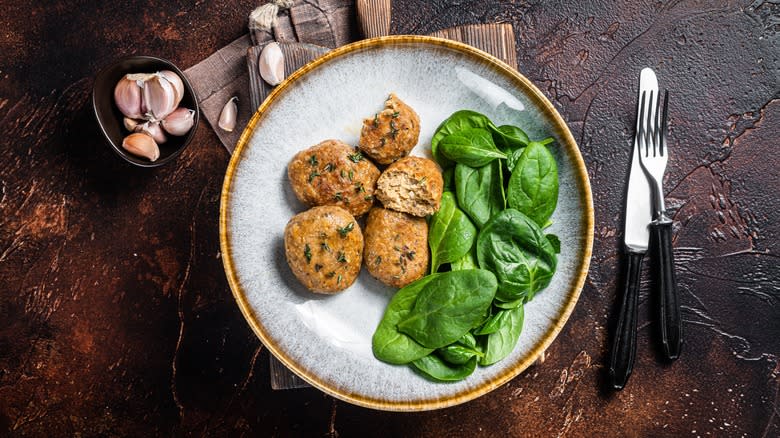
Think meatballs, and you think animal protein: Maybe chicken, maybe veal, maybe beef or pork, but definitely something from dry land. Don't sleep on seafood for incredible homemade meatballs, though. While it might seem strange, swapping regular meat for seafood can give you flavorful meatballs that have a briny, lighter taste and a delicate consistency. They are also delightfully versatile, being just as at home in a tomato sauce with spaghetti as they are in lettuce wraps, or with a white wine sauce and roasted potatoes.
When making seafood meatballs, remember that the seafood you choose will significantly affect their flavor. Going for an oilier, "fishier" seafood like salmon will make them taste heavier. Conversely, more subtle seafood like minced shrimp or crab will give you a more delicate taste. Although you can use your standard seasonings for these kinds of meatballs, we advise you to go for additions that work better with your seafood's natural flavor profile. Try pouring a little soy sauce into your mix, to balance out the seafood's light notes with more savory depth, or you could even add Cajun seasoning to give them a Louisiana shrimp boil flair.
Swap Your Onions For Shallots
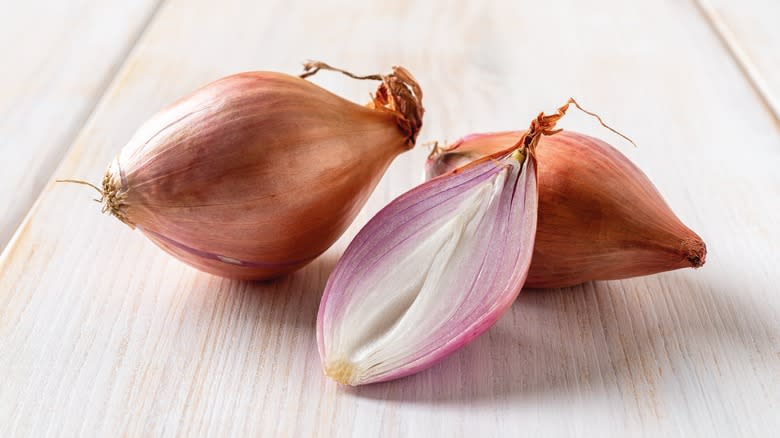
Onions are a standard ingredient in meatballs, but they're not a standard ingredient in themselves. Alliums come in many different shapes and sizes, and your choice can significantly affect the flavor of your dish. Using shallots instead of onions is an easy way to give your meatballs more delicacy and a gentler fragrance.
The difference between onions and shallots goes down to their growing habits: Onions grow individually, with their bulbs being distinct, while shallots grow more like garlic bulbs, bunched together. This makes them a sort of middle-ground between onions and garlic, with a flavor to show for it. Shallots have a slightly sweeter, less acidic flavor than onions and a definite garlic-like fragrance that adds a surprising amount of depth to meatballs.
While you can add raw shallots to your meatballs, mincing them finely and stirring them through the mixture, caramelizing them beforehand gives you even more flavor. When caramelized, shallots turn super-sweet, with caramel notes that round out your meat and seasonings.
Don't Use Breadcrumbs — Use Oats Instead
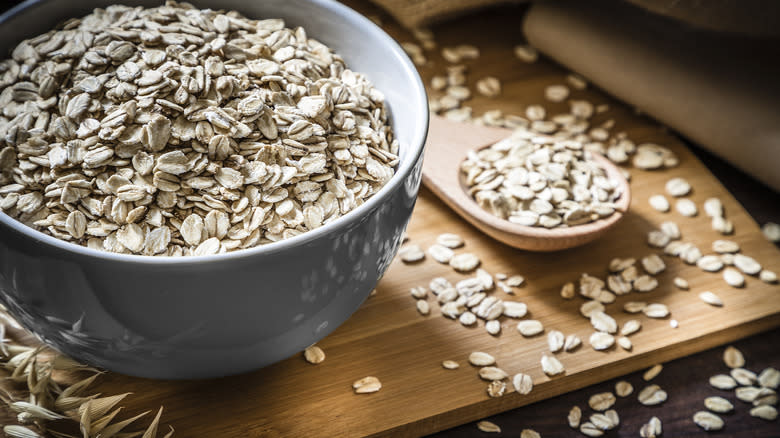
One of the best swaps for breadcrumbs in meatballs is an ingredient you're probably already using for your breakfast. Oats have long been used as a binder for meat-based dishes and are the traditional binding ingredient for haggis. When used here, though, it's an ingredient that will take your meatballs to the next level, thanks to its unparalleled ability to retain moisture.
This capacity for holding moisture makes oats especially useful in lower-fat meatball recipes. Unlike breadcrumbs, which can get soggy and pulpy when moist, oats have a robustness to them that helps them remain moist and firm simultaneously. They also have a neutral flavor, making them imperceptible in virtually any meatball recipe.
It's entirely up to you which type of oats to use. If you prefer a subtler presence and a smoother texture to your meatballs, go for steel-cut oats, so called because they're sliced into smaller pieces. If, however, you want your oats to stand out more, opt for old-fashioned porridge oats. Remember, though, that the less your oats are processed, the bigger and firmer they tend to be, so you'll need to add enough moisture to soften them sufficiently.
Swap Out Several Ingredients At Once With Italian Sausage

Although meatballs seem as simple as throwing a load of ingredients into a bowl and mushing them together, there's a lot of chopping involved beforehand, especially if you're using vegetables. Then, once you get these vegetables into your meatballs, you can find that they don't pack a punch. Skip the work and the disappointment by using Italian sausage. Italian sausage is full of seasonings that come from vegetables, like onion and garlic powder, as well as dried herbs like parsley and oregano. When added to meatballs, they infuse your meat with immediate flavor, fast.
Italian sausage also gives your meatballs an extra boost of fat, making them juicier. Plus, the added meat source you gain by using sausage gives them a totally new dimension of flavor, giving you a meat blend that rises above just using beef or pork. As some Italian sausages contain red pepper flakes or nutmeg, they can also give your meatballs a hint of spiciness. The best part is that you can grab a pack of Italian sausage when you're picking up your ground meat -- they usually sit in the same aisle in the store. It doesn't get easier than that, folks.
Instead Of Egg, Use Ricotta
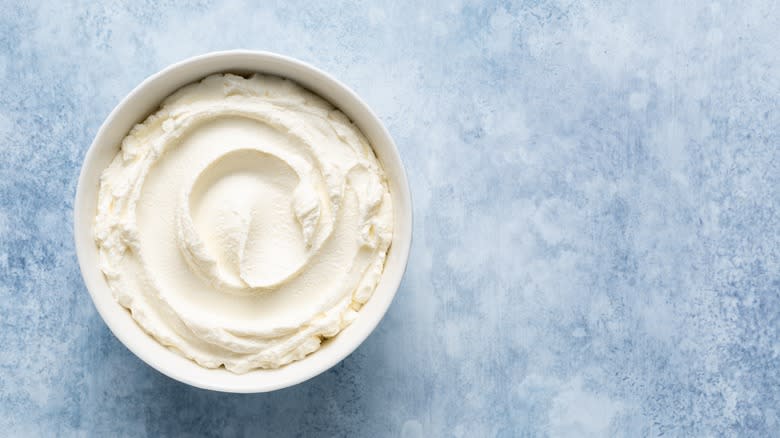
If you want to make the creamiest meatballs imaginable, reach for ricotta. Ricotta is the star ingredient for cooking ultra-juicy meatballs in your air fryer and is an upgrade from using eggs that give your meatballs an excellent amount of dairy fat and moisture. This soft cheese doesn't make your meatballs taste cheesy, as you might expect, but instead gives them a cream-like flavor, which remains when they're cooked.
Ricotta is particularly useful as an ingredient swap for eggs as you don't require any additional liquids when you use it. Instead, your meatballs remain firm and plump, while still being moist. As with any binder, though, you need to be careful when using ricotta. Don't mash it into your meat too much, and instead only mix it until the ingredients are combined. Overmixing can reduce your ricotta's fluffiness and cause the meat to toughen up, reducing its tenderness. It is also generally lower in salt than other cheeses, but certain brands can be pretty sodium-packed. So, if you're swapping your eggs for ricotta, you'll need to add less salt elsewhere.
Rather Than Spices, Use Sambal
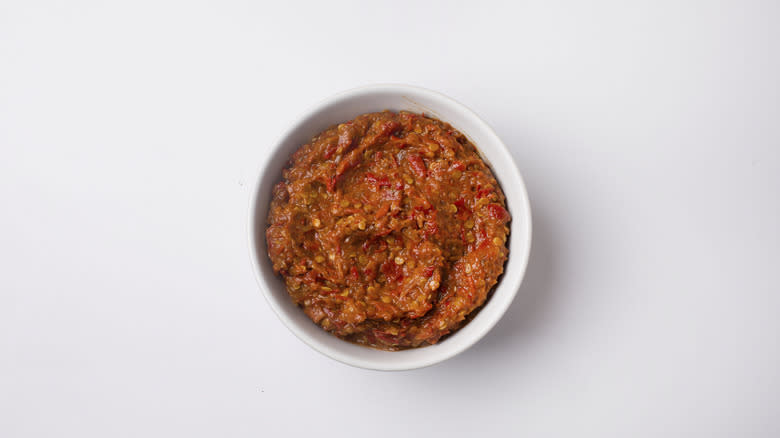
Infusing your meatballs with fiery spices is one of the best ways to make them pop. Rather than figuring out a spice blend, though, save yourself the hassle and use sambal. This Indonesian chile paste is pretty simple, and in its most basic forms is a combination of chopped chilies, vinegar, and salt. This gives it an immediate fiery kick, which is cut through with a tanginess that gives your meatballs a more rounded flavor.
Many sambals also use additional ingredients like garlic and shrimp paste, giving them even more depth, which then goes straight into your meatballs. Because sambal is gently chunky instead of smooth, it flecks your meatballs with small red bursts, giving them a more attractive appearance. It's worth remembering, though, that sambal can be incredibly hot, and you only really know how spicy it is when you try it. It's therefore wise to do a taste test of a small amount before you put it into your meatballs. You may end up with a fiery mouth, but that's way better than putting in too much and making your meatballs inedible.
Skip The Breadcrumbs And Use Cheez-Its

Some ingredient swaps use unexpected items to amp up foods -- but none are more unexpected than Cheez-Its. A replacement for breadcrumbs, throwing crushed Cheez-Its into your meatballs can bind them together, while also giving them huge amounts of flavor. It's probably no surprise that they provide a serious cheesy note to meatballs, but they also season them effectively, imbuing them with salt. Don't feel bound by the Original flavor, either: To mix things up, try mixing in Hot & Spicy Cheez-Its for a little kick of spice, or go for its Extra Cheesy flavor to intensify the cheese taste even more.
Importantly, if you're making Cheez-It meatballs, you don't want to rely on the crackers alone to provide taste dimensions. The cheese flavor that Cheez-Its give is undeniably fairly processed and artificial, so add in some grated pecorino or parmesan to round things out somewhat. You should also loosen your mixture and add moisture with milk, as Cheez-Its can be pretty dry. If you don't have Cheez-Its, other snack crackers like Ritz can also be used as a binder. The world, and the cracker aisle, are your oysters!
Read the original article on Daily Meal

